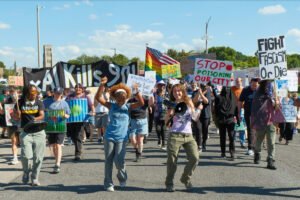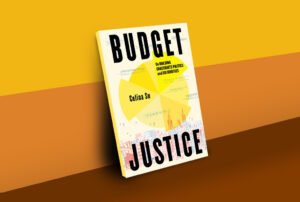
This is the second article in NPQ’s series, Just Transition: Liberating Finance to Build a Better World. Coproduced with Justice Funders, a group that organizes philanthropy to advance a just transition to an equitable and sustainable economy and planet, this series highlights case studies of emerging funding networks facilitating investment in liberatory economic practices in frontline BIPOC communities.
What happens when we make mistakes in a world that is ready for us to fail?
Venture capitalists fail all the time, but those working on a regenerative or solidarity economy1 do not have the same room to fail. We don’t have the same access to money, and often, the stakes feel too high to risk making mistakes. Still, the movement would be better served by being more playful and experimental—perhaps the stakes are too high not to move forward boldly. Practitioners developing financial practices that run counter to those centering monetary profit need to ask ourselves: how do we learn and take wisdom from trying different approaches and keep going, weaving these lessons into more liberatory versions of investing in our future?
We need support to take risks as we try new things. Regenerative finance is all about taking intelligent risks to advance a solidarity economy more effectively in ways that responsibly mitigate the climate crisis with communities at the helm.
Regenerative Finance: The Opportunity and Potential
Investors and funders must fundamentally challenge mainstream notions of risk and return to act in solidarity with the projects they seek to support.
When environmental and climate justice movement organizers gathered over a decade ago, they conceptualized the “just transition” framework to address the root causes in extractive capitalism that are driving the climate crisis—and provide a way out rooted in a vision of regeneration and a solidarity economy. The framework offers six complementary and interwoven strategies: 1) fight the bad, 2) build the new, 3) change the rules, 4) change the story, 5) build the bigger we, and 6) move the money. The Climate Justice Alliance (CJA), the group I work for, was formed to link communities working to counter the climate crisis in a powerful national presence.
Ten years later, these strategies have blossomed in many communities, giving new vocabulary to our ancestors’ practices. “Climate justice” and “just transition” were once fringe ideas but are now regularly used terms (whether used correctly or not) in spaces ranging from the United Nations and international policy convenings to the US federal government—and unfortunately, even fossil fuel companies—as they try to avoid their responsibility for the climate crisis.
The term “regenerative finance” also gets thrown around a lot. What do we mean by it? The idea is to move capital, particularly of impact investors and foundations, to invest in projects that implement just transition principles. But moving the money is not enough. Investors and funders must fundamentally challenge mainstream notions of risk and return to act in solidarity with the projects they seek to support. Operationally, regenerative finance may look like investing in projects with nonextractive terms, like 0 percent interest, that may benefit from previously untapped investments.
A few years ago, CJA began to lay the groundwork for “moving the money,” recognizing that many member organizations were already building valuable new projects that would democratize access to energy, such as community-owned solar power, transformative local food systems that center community-led urban farms, and other valuable locally rooted efforts that change our social and economic relationships with one another.
Today, through the Our Power Loan Fund, CJA aims to move $100 million in investments currently housed by philanthropy and other impact investors to support climate justice goals. The available philanthropic capital is over $1.5 trillion. While $100 million is a small down payment, it’s a start toward a long-term goal of shifting capital and power to frontline communities.
In contrast to many mainstream loan funds, the Our Power Loan Fund is democratically governed by a committee composed of CJA members. The term sheets are co-created by the fund in cooperation with the loan applicants themselves. This means outright rejection is rare. Instead, projects are assessed on their level of “readiness,” and if not ready, they are coached and their projects are incubated by “project stewards” until they are ready (or the project finds other support). When a group reaches an appropriate state of readiness, project stewards help put together the loan application and advocate on their applicant’s behalf in front of the loan committee.
“When we prepare a loan package, I have to present the loan application myself. I’m part of the [loan] committee, but I’m 100 percent on the side of the project. It’s my role to advocate for them, champion them, get them the financing—and of course, to do the due diligence and get all of their ducks in a row first,” says Pia Desangles, a loan fund project steward.
Early Lessons in Building a Democratic Loan Fund
There is no tried-and-true formula for building a democratically governed loan fund. There are a growing number of loan funds designed to be responsive to the needs of the communities they serve, but everyone is learning as they go at the same time. Seed Commons, Kheprw Institute, and Justice Funders are examples of other loan funds doing similar work.
But even as we turn to one another for peer-to-peer support, there are many new horizons to encounter.
One loan fund challenge is navigating how to be a lender in each state and territory: “All the other loan funds we work with that we are in learning communities with are place-based. We’re not. We are created to serve CJA’s member communities, which is amazing, but they are spread out throughout 50 states and US territories. The support infrastructure for nonextractive loans and cooperatives varies place by place,” says Desangles. “It’s a huge administrative burden and challenge for a team of our size.”
The design of the loan itself is also a question. It has been a learning process building banking infrastructure and tracking systems that can be nimble and responsive to project needs and timelines. “We’ve been learning about the different infrastructure components we need from aligned banking institutions that process transactions in a way that will allow us to service loans on time,” says coauthor Lauren Ressler, who helps administer the loan fund.
Sign up for our free newsletters
Subscribe to NPQ's newsletters to have our top stories delivered directly to your inbox.
By signing up, you agree to our privacy policy and terms of use, and to receive messages from NPQ and our partners.
Building a regenerative, solidarity economy within the existing one is a bit like trying to fit a square peg in a round hole—and we have had to adjust our practice along the way. For instance, the Our Power Loan Fund was first housed within a donor-advised fund (DAF) structure. This seemed to be a logical choice that would allow the fund to deploy money quickly.
But we soon learned that using a DAF carried restrictions. Loans could only be in the form of “recoverable grants,” which, like a loan, allows the money to be paid back if the business is successful, but legally, and for tax and accounting purposes, is considered a grant and not a loan. Since, technically speaking, these were grants from a DAF and not loans, the fund, as originally structured, could only provide financing for nonprofit-owned businesses and couldn’t make business loans to other important contributors to a regenerative, solidarity economy, such as for-profit cooperatives.
Our “logic model” is centered on the idea that changing the structure of the economy requires changing who makes economic decisions.
To create a fund that would enable investment to flow to the types of enterprises like the co-ops we wanted to support meant the loan fund had to be structured quite differently. This also meant there was a transition from the original fund structure to a new fund structure and relationships that now need to be managed.
The Our Power Loan Fund maintains a positive relationship with the original entity that housed it. For example, we plan to continue collaborating with them for technical assistance in grantmaking. However, we are in the process of moving the fund to a more suitable financial institution.
Our key needs in making a democratic loan fund work—good things to keep in mind if your community sets up a similar fund—include: (1) an institution with a history of cooperative finance and lending, (2) access to a peer network of other practitioners to learn from, and (3) the availability of sophisticated technological infrastructure for easy reporting and tracking on the status of investments—both for us to track money going into the fund and for servicing the loans so that when project partners begin repayment, fund investors can easily see where their investment stands.
In short, building structures that can begin to finance a just transition to a regenerative, solidarity economy is not easy. The above provides a taste of the time and energy needed to align our systems. But it has been worth it. We are building habits and logic systems that keep money circulating within communities and reinforce just transition to societies by and for us, not ones designed for the accumulation and hoarding of wealth and resources.
Building the Ecosystem
Our lives and futures depend on building a just transition to a regenerative, solidarity economy. It sounds simple, but it’s a profound shift that is bigger—and we hope more enduring—than choosing the right fund structure, checking off a list of ethical criteria, or defying traditional lending. It’s about world building. We are centering how and what we grow together—not profit maximization at the expense of others.
How does this occur in practice? Our “logic model” is centered on the idea that changing the structure of the economy requires changing who makes economic decisions. For this reason, the authority for making loan fund allocation decisions is broadly distributed. Leaders from different cohorts of the governing body of the Our Power Loan Fund continue to advise as ex officio nonvoting members or support building out a political education curriculum about what just transition finance looks like. Project partners often later serve as members of the Our Power Loan Fund governing committee. We seek to build an intergenerational space and community where we can reach out at any time to seek expertise and wisdom from a wealth of practitioners. Our succession plan is self-generating.
A regenerative, solidarity economy is not just about building successful community-owned businesses. It’s also about changing policy and culture.
We also center partnership building in our loan fund design. A key role in this regard is that of the “project steward.” Project stewards serve as liaisons between the fund and the businesses that receive loans from the fund. They are in relationship with these businesses (who we also call “project partners”) to maximize their success before, during, and after a loan.
Looking Forward
The businesses that receive fund loans understand that their work extends far beyond building a resiliency hub, a renewable energy cooperative, or a locally sourced grocery store. Rather, the people in these businesses view their work much more broadly than that. Developing a regenerative, solidarity economy is not just about building successful community-owned businesses. It’s also about changing policy and culture. The entire Climate Justice Alliance ecosystem, including its policymaking and culture building parts, aims to support the success of these businesses.
There is a long road still to travel, but we believe we have begun to create systems, habits, and conditions that will allow us to more effectively support cooperative, democratic ownership within communities while increasing community leadership, capacity, and collective power.
- At CJA, we typically use the term “regenerative economy” to emphasize developing an economy consistent with the just transition principles and honor the language that came from the work of environmental and climate justice leaders. Here, for the purpose of consistency across this series, we use the phrase “solidarity economy” which also includes sustainability among its core principles and shares our commitments to just transition principles and to building a postcapitalist economic system.








